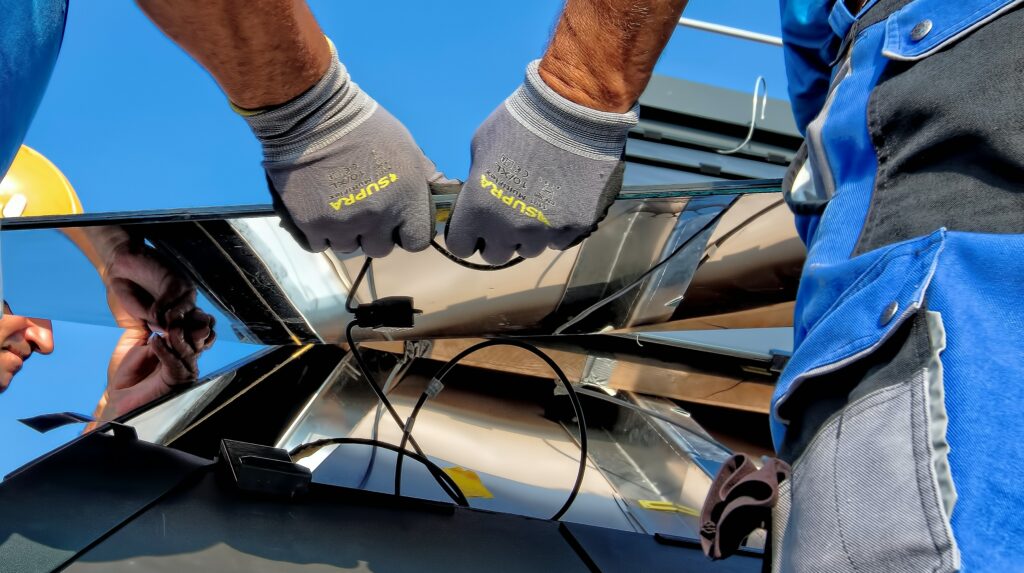Job Closeouts, or JCOs, represent a crucial yet often overlooked phase, marking the culmination of any solar and renewable installation project. This final step bridges the gap between project completion and operational success.
In this blog, we’ll delve into:
- The essence of job closeouts
- Their indispensable role in the lifecycle of renewable energy projects
- The detailed practices for conducting them effectively
- The common challenges faced by technicians and project managers
- How modern technology is playing a pivotal role in streamlining these processes and reducing costs
What is a Job Closeout Exactly?
JCOs are the final yet pivotal phase in the lifecycle of renewable energy installation projects. This phase encompasses a series of critical steps undertaken after the installation work is completed. The primary objective of a JCO is to ensure that the project meets all the predefined criteria for functionality, safety, and compliance. It involves a comprehensive review of the project against its initial design and contractual obligations.
This review process includes checking the installation for any defects, ensuring all systems are functioning optimally, and verifying that the project adheres to all relevant local and national regulations. It’s a process that ensures the sustainability and long-term viability of the project.
In simpler terms, think of a JCO as a thorough final inspection and wrap-up operation. It’s not just about making sure the solar panels are properly installed or the EV charging stations are functional—it’s about confirming that every aspect of the project aligns seamlessly with technical specifications, safety standards, and client expectations. This stage often involves multiple stakeholders, including project managers, installation teams, clients, and regulatory bodies. Each plays a distinct role in certifying that the project is completed to the highest standards.
The JCO process also includes the handover of all necessary documentation to the client, such as operational manuals, warranty information, and maintenance guidelines. It’s the stage where the project transitions from being a construction site to a fully functional renewable energy installation.
Another notable aspect of the Job Closeout or JCO milestone is its typical relationship to release of project progress payments. Typically installation project payments are released as various milestones are achieved, with the final portion held back pending the successful completion of the Job Closeout process. For this reason, solar and other renewable energy EPCs and Installers are incented to ensure this process is completed as thoroughly and as quickly as possible since failing to do so will stretch out receivables and adversely impact cashflow.
How to Execute a JCO
Conducting a Job Closeout (JCO) in renewable energy installations is a detailed and methodical process. It demands meticulous pre-planning, attention to detail and a structured approach to ensure that every aspect of the project meets the required standards. Here’s a step-by-step guide to effectively conduct a JCO:
- Documentation Review: The first step is to gather and review all project-related documents. This includes contracts, design documents, permits, inspection reports, and installation records. The aim is to ensure that all paperwork is complete, accurate, and in compliance with project requirements.
- Physical Inspection: Conduct a thorough physical inspection of the installation. This involves checking the structural integrity, verifying the installation of all components as per design specifications, and ensuring that safety standards are met. For solar projects, this might include inspecting the solar panels, inverters, and mounting systems.
Note: it is important to ensure that at least some of the essential inspection steps are carried out in tandem with the completion of installation steps since some equipment may become obscured or inaccessible for testing or photo capture. For example, if the Job Closeout requires verification of racking or mounting fixtures or fasteners, this can only be completed prior to the solar panels being installed since otherwise the equipment will be obscured and may necessitate a costly and time-consuming panel removal. - Performance Testing: This is crucial to ascertain that the system operates as intended. For solar installations, performance testing might include measuring panel output under various conditions.
- Regulatory Compliance and Permission to Operate (PTO): Ensure that the installation complies with all relevant local, state, and federal regulations. This may require coordinating with regulatory bodies for final inspections and obtaining necessary approvals or certifications. If your company operates in multiple Authorities Having Jurisdictions (AHJs) and so-called “wire owners,” or utilities, equipping your team with the appropriate checklists for each set of requirements will ensure a smooth JCO and subsequent PTO and interconnection process.
- Client Training and Handover: Educate the client on the operation and maintenance of the system. Provide comprehensive training on monitoring systems, emergency procedures, and routine maintenance tasks. Hand over all necessary documentation, including operational manuals, warranty information, and maintenance schedules.
- Finalizing Financials: Ensure that all financial aspects of the project are settled. This includes submission of the JCO report to the appropriate finance or manufacturers, issuing final invoices, processing final payments, settling accounts with contractors and suppliers, and resolving any financial disputes.
- Feedback and Improvement: After the JCO is completed, gather feedback from all stakeholders. This feedback is invaluable for identifying areas of improvement for future projects. It also helps in building better client relationships and enhancing the overall quality of project delivery.
The Importance of Photos in JCO Reports
Incorporating photos and media in solar job closeout reports is critically important. For professionals in the solar industry, these visual elements serve as a key tool for quality assurance. Manufacturers and other national brands, particularly those with extensive dealer networks, rely on these photos to verify that installations meet their high standards. This visual documentation is often essential for the processing of invoices, underlining its significance in the business aspect of solar installations.
Additionally, photos in JCOs are invaluable for detailed record-keeping. Solar professionals who manage the entire process from sales to service find that providing clients with a detailed photographic record of the installation not only reassures them of the work’s quality but also serves as an important reference for future maintenance or expansion.
Capturing specific details is crucial in these reports. This includes proper installation of flashing around conduit penetrations, recording model and serial numbers of installed equipment, and clear images of the electrical setup, especially the main supply panel. These elements are not just for accountability; they also facilitate warranty claims and ensure adherence to safety standards. Essentially, the inclusion of accurate and comprehensive photos in JCOs creates a detailed, auditable record of the completed project, emphasizing the importance of visual documentation in the solar industry.
For more information, read our blog on can’t miss photos for a JCO report.
The Challenges of Conducting JCOs
The challenges that come with executing JCOs can have far-reaching impacts, affecting not just the immediate project but also the long-term viability and reputation of the energy provider. Understanding these challenges and their consequences is crucial for professionals in this field.
Data Management and Human Error
One of the most significant challenges of conducting JCOs is the reliance on manual data management. This method is not only time-consuming but also prone to human error. Manual handling of extensive project documentation, performance data, and compliance records increases the risk of inaccuracies. These errors can lead to misinterpretations of project outcomes, potentially resulting in non-compliance with regulatory standards and contractual obligations.
Communication and Coordination
Effective communication and coordination among the various stakeholders involved in a renewable energy project can be difficult and time-consuming. The absence of centralized platforms for information sharing can lead to miscommunications, delays in decision-making, and inefficiencies in project execution. This lack of coordination can significantly prolong the job closeout process, increasing project costs and frustrating stakeholders.
Quality Assurance and Compliance Tracking
Quality assurance and compliance tracking are integral to JCOs. Monitoring these aspects accurately is a daunting task. It becomes challenging to ensure that every component of the installation adheres to the required quality standards and regulations. This can lead to overlooked defects, subpar installation practices, and potential safety hazards.
Adapting to Regional Requirements
Another JCO challenge stems from the varied regulations set by AHJs. Given that each AHJ – be it at the city, county, or state level – has its unique set of building, electrical, and safety codes, along with specific zoning laws, renewable projects must navigate a patchwork of regulations. This diversity demands customized compliance strategies for each location, often complicating the permitting and approval process, and adding layers of challenge in the JCO phase.
Impact of an Inefficient or Incomplete Job Closeout
Job closeouts are the final and arguably most crucial phase in a solar job. They’re the last step you take before you can move on to new projects, and they’re the last impression you leave with a customer. They’re also, without a doubt, the most sensitive phase of a residential project. Generally speaking across renewables, construction, and other industries, Job Closeout can make or break your project performance.
If you ask any solar project manager what the most error-prone, time-consuming portion of any job is, they’ll all tell you that job closeouts represent a huge time sink of team members’ bandwidth and often come at the cost of customer satisfaction. But what if that didn’t have to be the case?
What if your project managers didn’t have to approach a JCO with dread, crossing their fingers that they don’t fail another site inspection. What if they didn’t have to fight incorrectly documented information, poor technology syncing, and hours of unfruitful manual searching only to force another costly repeat site visit? We’re here to tell you that you and your project managers don’t need to settle for the status quo.
Streamlined JCO with Scoop
Software such as Scoop offers configuration flexibility that empowers your project managers to standardize documentation processes and mandate exactly what is needed to pass an inspection for any given job, adapting automatically to specific regional and customer requirements.
The right software also empowers your whole team to perform their portions of the process with a mobile and desktop accessible, industrial strength app that is designed for ease of use. This means your field teams are able to view, document, and capture key project information from anywhere–even offline.
Other features that simplify solar project job closeout are:
- Configuration flexibility: empower your project managers to mandate steps and data asset collection for every phase of a project to ensure every piece of data, measurement, documentation and images are exactly what is needed to pass inspection.
- Innovative global data fields: necessary text and picture data that is captured throughout the work process is stored centrally for throughout the whole project, and available when needed during closeout.
- Conditional adaptive logic: that helps your various project checklists, required photos and JCO steps adapt automatically to the type of project, AHJ and utility requirements ensuring a flawless JCO despite the complexity.
- PDF report wizard: effortlessly generate a ready-to-submit report that includes all relevant measurements and pictures.
- Report automation: transmit the PDF report to stakeholders automatically via email (or API integration where available) when the JCO checklist is complete.
Increase Efficiency with the Solar Job Closeout App
Scoop’s automation and user-friendly features unlock a world of workflow efficiencies that are generating 20-30x cost saving ROI for our customers.
JCO reporting doesn’t have to be burdensome. In fact, a lot of the information you need to collect is in picture form. There are a few reasons why a formal solar job closeout report may be required. For instance, manufacturers may require them for quality assurance, your solar energy business may require a record of what you’ve installed, and more. The Scoop Solar Job Closeout App uses checklists, workflows, and automation to make sure crucial steps and photos aren’t missed.
Learn more about the Solar Job Closeout App.
Conclusion
In summary, Job Closeouts (JCOs) are a pivotal part of any solar or renewable energy project, ensuring each installation meets the highest standards of quality, safety, and compliance. While the process can be challenging, especially without the aid of technology, modern solutions like Scoop offer a transformative approach. By integrating technology, the complexities of JCOs become manageable, turning a potentially burdensome task into a streamlined, efficient process. This not only saves time and costs but also enhances overall project success and customer satisfaction.
Interested in revolutionizing your solar project’s job closeout process? Book a meeting with a Scoop expert today and discover how we can help turn your project closeouts from a challenge into a success story.




